|
|
Post by Don Ricardo on Oct 27, 2016 21:48:23 GMT 10
|
|
|
|
Post by Roybeth on Dec 29, 2016 17:07:23 GMT 10
Not sure if this ad has been posted before - I didn't spot it so hopefully here's a newie for the Superb model - ad is apparently from 1949. 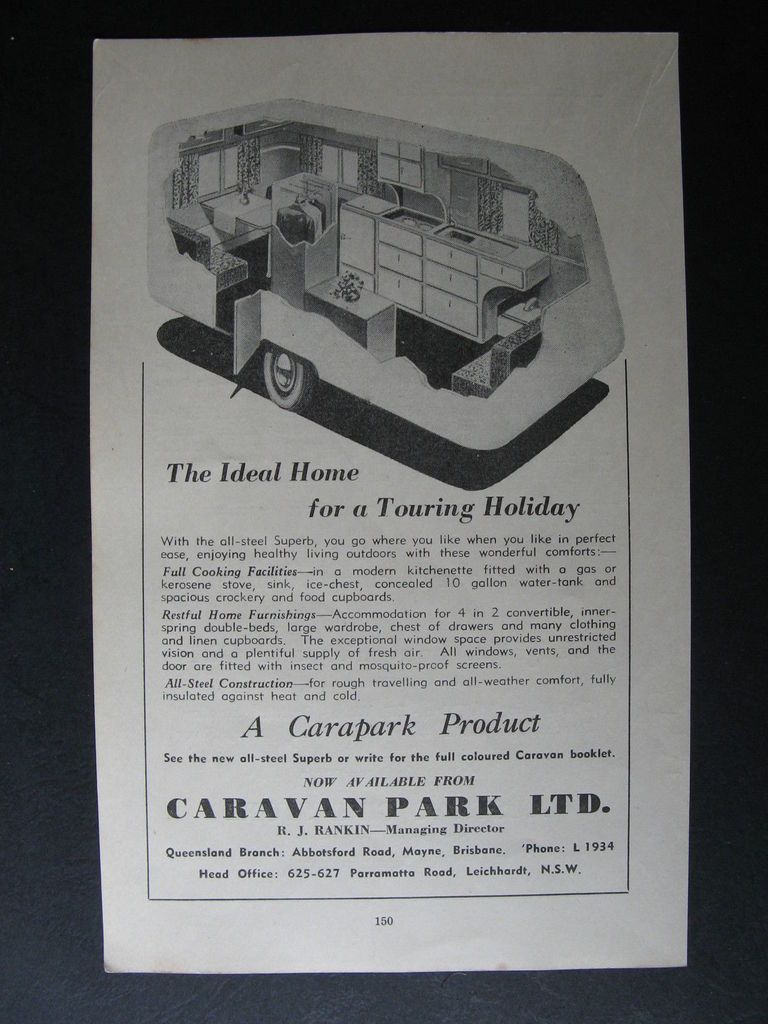 |
|
|
|
Post by Don Ricardo on Apr 26, 2017 21:34:18 GMT 10
Photos of a post-1957 Carapark 10/9 refurbished and re-purposed by Stevej, posted here on 16 March 2017:  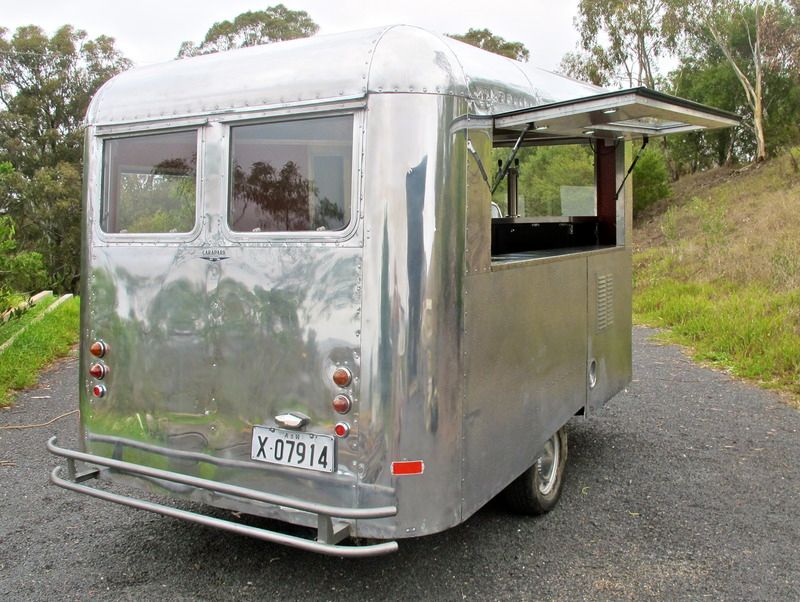
Following a question about the sloping roof and the shape of the windows on this van, Stevej provided the following information about the development of the 10/9 design in a post on 17 April 2017:The rear windows and bumper on this van were an older adaption, I suspect done in the 70's or later to match a vw split screen tow car, the tail light footprint was VW also but the lights were missing so I am not 100% sure. I left the rear windows and bumper as I found them, I quite like the look and it is part of the vans history. Strangely Carapark stuck with the fixed rear window for their entire toaster production, but given the prevalence of dirt roads back then I understand why they made this decision. We convert the rear windows to open in all our vans. The sloped roof is an original feature of post 1957 10/9s (and 12/9's), they are very low in the rear interior, I would surmise the bed went there which reduced the need for head room (?). I am yet to find a flat roofed pot 57. The 55/56 always have the flat roof. This 'slit side window' is a post 1957 feature also, although the more standard 'rectangular rear side and forward porthole window' did persist after 57. I have an early 55 that has no rear window, the narrow front window (as found on all vans pre 57) and only standard single side windows. It has the standard 55/56 flat panel door (none venting), it is the earliest 55 I have come across, very plain little van. All post 57 vans had the opening screen door inserts in the door and a larger rectangular roof hatch (as opposed to the smaller square roof hatch of 55/56 van), this would have improved the cross flow ventilation greatly. I can really see constant ongoing design evolution in these vans, it is quite interesting, I suspect if the interiors survived a similar evolution would be apparent and we would be able to date them between 57 and 61/62 by the design evolution.
|
|
|
|
Post by Don Ricardo on Aug 1, 2017 10:29:17 GMT 10
Report on the opening of a new Carapark showroom in Melbourne in 1953: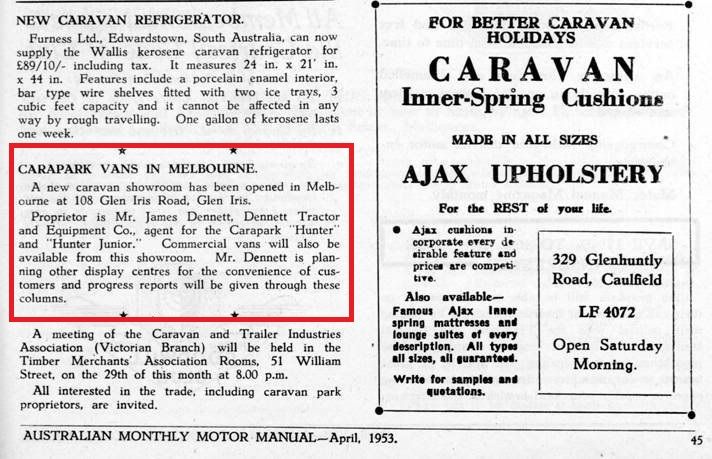 (Source: Australian Monthly Motor Manual, April 1953, page 45) This extract was originally posted by Franklin1 on 24 April 2008 in relation to Furness caravans (see top item).
|
|
|
|
Post by Roehm3108 on Nov 6, 2017 8:01:58 GMT 10
Here's a little puzzle for Carapark owners or other historians. At what point in the history of this company did they call their vans Caraparks? The term seems to predate to a time when the company was still called Caravan Park Ltd,
|
|
|
|
Post by Don Ricardo on Nov 6, 2017 17:19:39 GMT 10
G'day Roehm, You knew I wouldn't be able to resist responding didn't you?    As best as I can discover at this point, Caravan Park Ltd first started advertising their products under the 'Carapark' name in December 1949. The following adverts were all placed in the Newcastle Morning Herald and Miners Advocate newspaper on Saturday, 3 December 1949 (page 7): 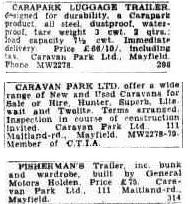 [/a] (Source: National Library of Australia nla.gov.au/nla.news-article134175537 ) The first advert refers to the 'Carapark Luggage Trailer' which was a 'Carapark product' built by 'Caravan Park Ltd'. The second advert lists Caravan Park's caravan model line up as the Hunter, Superb, Litewait and Twolite, but does not refer to them as Caraparks. Interestingly, there is no mention of the Hunter Junior model, introduced in July 1949, or the Hunter Minor model, that was introduced in 1949 or early 1950. The third advert I've included as an interesting piece of trivia, or maybe it's more? That advert tells us about a 'Fisherman's Trailer' that incorporated a bunk and wardrobe. The Fisherman's Trailer was available from Caravan Park, and cost more (£75) than the Carapark Luggage Trailer (£66/10/-). But the most intriguing thing about the Fisherman's Trailer was that it was built by General Motors-Holden. From time to time there has been discussion on the forum about Holden-built caravans, and a while ago Griffin posted an advert for a Holden caravan here, but perhaps Holden had a few goes at getting into the "leisure market"? Getting back to the Carapark/Caravan Park question, a couple of weeks after the Newcastle Morning Herald adverts (which I should add was the first of many similar adverts over a period of several weeks and more), the following advert was published in the Sydney Morning Herald on Friday, 16 December 1949 (page 12):  (Source: www.newspapers.com ) The advert is for a 'Carapark All-steel Box Trailer' which was the same price as the previously advertised 'Carapark Luggage Trailer', so I think we can assume they were one and the same product. In any case, the Carapark Box Trailer was available from Caravan Park's sales rooms in Summer Hill (Sydney). This next group of adverts was printed in the Newcastle Morning Herald and Miners Advocate on Saturday, 7 January 1950 (page 9): 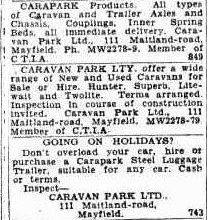 (Source: National Library of Australia nla.gov.au/nla.news-article140628957 ) The second advert in the group refers to the same list of Caravan Park models, and the third advert refers to the 'Carapark Steel Luggage Trailer'. However, I thought the first advert were of interest because it refers to 'Carapark Products' more generally, and advertises a range of items which would have been of interest to home builders. So, after all that...December 1949 seems to be when Caravan Park began to use the 'Carapark' brandname...! But when did they start actually branding all their caravans as 'Caraparks'? Maybe I need to do a bit more research...? Don Ricardo |
|
|
|
Post by Roehm3108 on Nov 6, 2017 21:36:38 GMT 10
Being the investigative historian that you are, I knew you would look into this further DonR. It does seem strange though that they used the term Carapark quite loosely when all their badging was for Caravan Park Ltd. Perhaps the term Carapark was coined to simplify the brand name for advertising and common useage and thence became Carapark in the mid/late fifties, when (I think) there was a merger with another caravan manufacturer. Perhaps a bit of a chicken/egg situation???
|
|
|
|
Post by Don Ricardo on Nov 7, 2017 17:00:19 GMT 10
Hi R3108, I'm not sure that Caravan Park began to use the 'Carapark' brandname loosely as you suggest. I think it was probably a part of a deliberate strategy, because in late 1949/early 1950 their adverts all seemed to adopt the 'Carapark' name for their products, whether they were caravans or caravan components. As mentioned in my previous post, Caravan Park Ltd was selling a 'Carapark Luggage Trailer' in December 1949. Then on Sunday, 26 March 1950, they published this rather magnificent full-page advertisement in the Sydney Sunday Sun Supplement Color Magazine (pity it's been copied by Trove in B&W!) which refers to 'Carapark caravans':  (Source: National Library of Australia nla.gov.au/nla.news-article230171746 ) If the text is a little hard to read, here's a clearer version (interesting to note the number and locations of Caravan Park's agents at that point too): 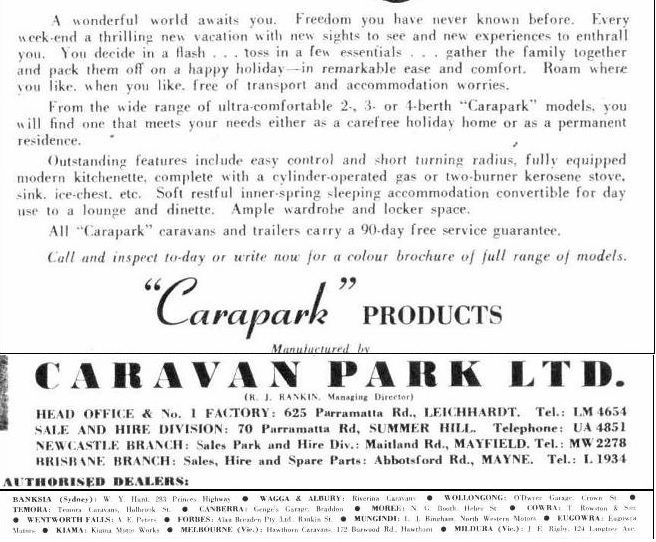 As can be seen, the advert refers to 'Carapark models', 'Carapark caravans and trailers' and 'Carapark products', manufactured by Caravan Park Ltd. From that date on all the Caravan Park adverts I can find refer to 'Carapark caravans' manufactured by Caravan Park Ltd. There are quite a lot of adverts from 1950 through to 1954 posted on this thread which show this branding, and this is consistent with the photos of Phargan's Hunter Minor here which has a name plate on it saying that it was 'Built by Caravan Park Ltd'. This van would almost certainly have been sold branded as a Carapark, because the name plate says 'Built by Caravan Park Ltd'. You want to know how I can feel so certain? Thanks for asking...read on...    During its history, Caravan Park/Carapark went through an extraordinary number of company restructures. I have a whole file on their re-organisations - which I haven't posted because my head spins whenever I look at it.    I won't bore you with all the detail, however a handy brief version is provided by two newspaper articles. The first was published in the Newcastle Morning Herald and Miners Advocate (surely the newspaper with the longest name in Australia?) on Tuesday, 8 November 1949 (page 6): 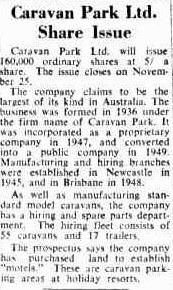 (Source: National Library of Australia nla.gov.au/nla.news-article134174238 ) This tells us that: - 'Caravan Park' was established as an unincorporated business in 1936. We also know from previous posts that R J Rankin, the founder of Caravan Park, began manufacturing caravans in 1928, so I'm guessing that up until 1936 he was probably building the caravans under his own name.
- Caravan Park was then incorporated as a proprietary (private) company in 1947 - so was known as 'Caravan Park Pty Ltd'.
- Finally the private company was converted into a public company - 'Caravan Park Ltd' - in late June 1949.
So what we learn from this is that 'Caravan Park Ltd' didn't come into existence until June 1949 - hence the name plate on Phargan's van can't be any older than that (and of course the Hunter Minor model was only introduced in late 1949 or early 1950).
There was a further Caravan Park company restructure in May 1954, as recorded in the Brisbane Telegraph on Wednesday, 5 May 1954 (page 29):
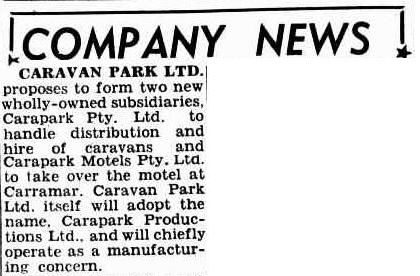
(Source: National Library of Australia nla.gov.au/nla.news-article217213803 )
This was when Caravan Park Ltd renamed itself 'Carapark Productions Ltd' and retained control of the manufacturing end of the business, but formed 'Carapark Pty Ltd' to look after the distribution and hire of caravans, and 'Carapark Motels Pty Ltd' to look after its (first?) motel. So the adverts after that point refer to Carapark caravans manufactured by 'Carapark Productions Ltd'. [Hope you're following all this?    As I said this is the brief version and only takes us up to 1954. There's much, much more after that (and a bit more before that as well)!] As I said this is the brief version and only takes us up to 1954. There's much, much more after that (and a bit more before that as well)!]
So 1954 was when the 'Carapark' company name and the 'Carapark' brand name were brought into alignment. But my hunch - based on reading a lot of adverts - is that Caravan Park made a quite deliberate decision at the end of 1949 to introduce the 'Carapark' name for all its products (caravans and components), possibly at the time of the 1949 restructure and the change from a private proprietary company to a public company.
The other thing I draw out of all this is that your own Hunter Minor van was almost certainly sold as a 'Carapark', not as a 'Caravan Park' - meaning that the Carapark signage on the van when you bought it was very probably correct (if not original), even if the date (1941) was almost a decade out.
By the way, your post mentioned a possible merger with another caravan manufacturer in the late 50's. There were some mergers or takeovers at that point (Gypsy and Paramount), but that seems to have been quite a few years after 'Carapark' rose up out of 'Caravan Park'. Or is there something else you're thinking of?
Don Ricardo
|
|
|
|
Post by Don Ricardo on Nov 8, 2017 16:45:56 GMT 10
Hi all, Interesting what you find when Roehm sets you a task! Yesterday when I was investigating the date on which 'Caravan Park' became 'Carapark' (see above post), I came across the following photos of a Carapark 'toaster' which was used as the 'command post' for Department of Civil Aviation aerodrome rescue operations at Brisbane Airport from the 1970's through to the early 1990's: 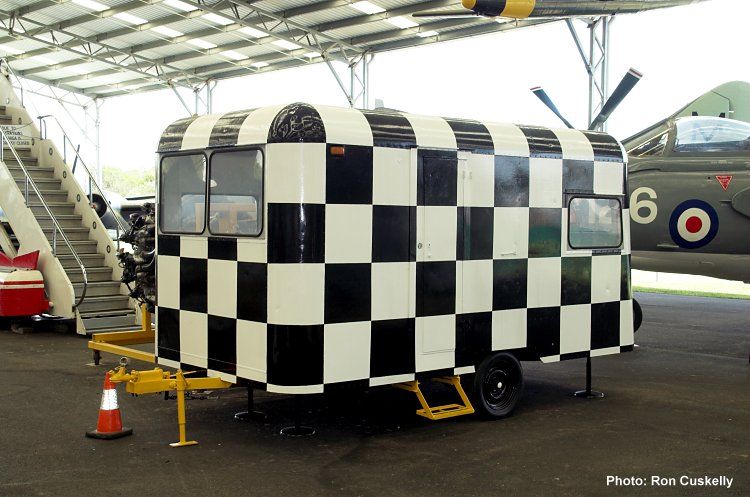 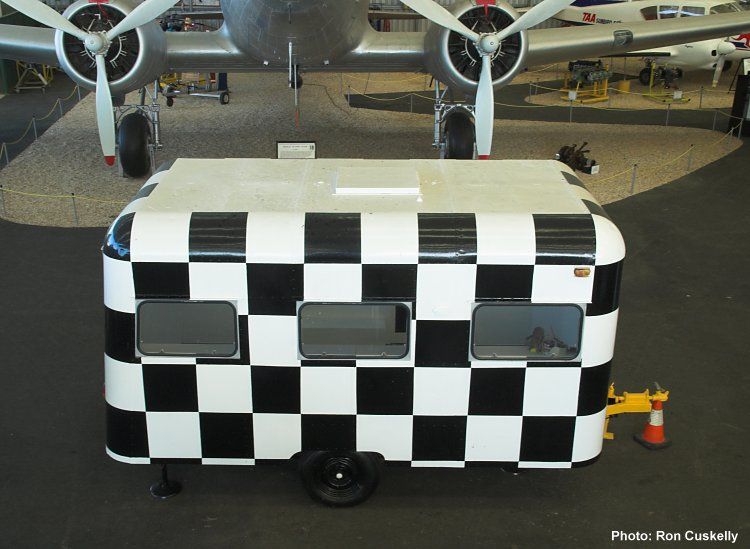 (Source: Photos linked from pandora.nla.gov.au/pan/100181/20150717-0001/qam.com.au/qam-content/misc-exhibits/command-post/command-post.htm ) After becoming surplus to requirements, it was used as a site office for an auction house, and in 2009 was acquired by the Queensland Air Museum in Caloundra, where it was refurbished and is now used as an instrument overhaul facility. Although the van was used at the Queensland Airport from the 1970's on, it is almost certainly a 'vintage van' (ie pre-1970) because Carapark ceased production of the toaster models sometime in the mid to late-60's. Interesting to see the windows which have been fitted to it at some point. More information about the history of the van can be found here. It's an interesting story. Don Ricardo |
|
|
|
Post by Surf Tragic on Nov 9, 2017 22:41:18 GMT 10
That is an interesting article Don Ricardo, & now I know where the Museum is, it will be a place to visit if we get back there again. I found the Museum online & did a virtual tour, & see what looks like a chequered "form" in the background, similar in size to the van you featured, but too blurry for me to say for sure.
Surf Tragic.
|
|
|
|
Post by Don Ricardo on Nov 28, 2017 10:25:22 GMT 10
Photo of a Carapark Superb at Sandgate Caravan Park in 1952, posted on the Lost Brisbane Facebook page by Kaylene Wilson on 6 August 2015 here: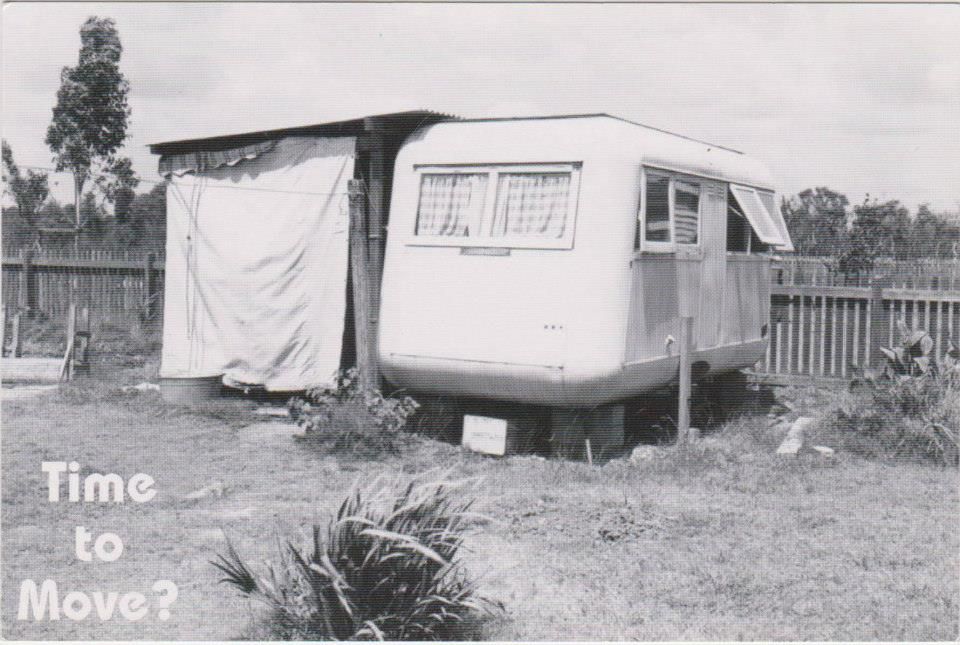 This photo is of interest because of the window configuration. Note the two sets of double windows on the offside of the van, and the divided window at the rear. This is the first time we have seen this configuration I think, and may be an aid to dating the steel cladded Superbs like this one. Here are some photos of other Superbs posted on this thread. First an example posted by Franklin1: 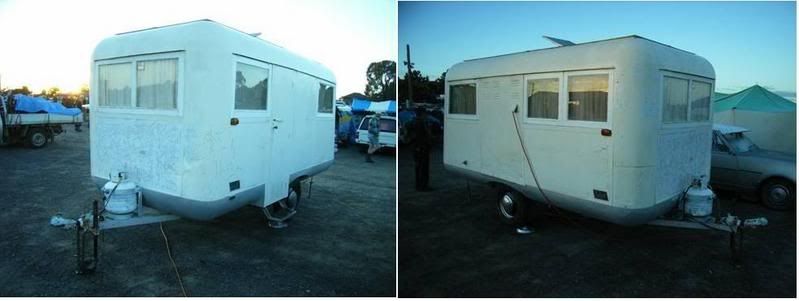 Note that this van has just the one window on the side at the rear. Next is a Superb that I think was once owned by Roehm3108:  This one has the two sets of double windows on the side, but the rear window is undivided. (Of course it is possible that the rear window was replaced with a single pane of glass at some point...) Don Ricardo
|
|
|
|
Post by drs777 on Mar 16, 2018 9:39:31 GMT 10
I believe I might be the proud owner of the Superb in the photo at Sandgate caravan park in 1952. I purchased this van not far from Sandgate last year 2017 from and old fella in Nundah who's deceased sister purchased it in the 70's. It is all in tacked with all of the cupboards and interior still there. There is a little rust in the front rounded metal sheet corners where water lay ( these corners were not galvanised) but all in all in great structural shape. The original Dunlop cross ply tyres which had cracked and were buried to the rims just pumped up and are holding the old girl up still. My wife fell in love with it so with her blessing, I am slowly bring the Average back to the Superb. I have just the tow car for this caravan also. I will keep you posted on the progress.
David
|
|
|
|
Post by stephen&Julie on Mar 22, 2018 19:03:04 GMT 10
Carapark 15/5 'Astronaut' Rescue, have passed on to an excited couple for restoration, thats what its all about    Cheers Stephen&Julie |
|
|
|
Post by brocoli on Sept 15, 2018 16:30:57 GMT 10
We have finally become the proud owners of a Superb 12’9 .. very excited here ... not sure how to post pics 😊
|
|
|
|
Post by Don Ricardo on Sept 15, 2018 21:04:31 GMT 10
Hi Brocoli,
Welcome to the forum, and congratulations on your acquisition. That sounds great.
There are instructions on how to post photos in the 'Forum Guidelines & Helpful Hints' section of the forum. Basically you need to upload your photos to a photo storage website, such as Flickr or PostImage, then copy and paste a link for the photos to your forum post. If you have any trouble give us a yell and one of us will help you out (or post your photos for you).
We'll look forward to see the photos of your Superb.
Don Ricardo
|
|
|
|
Post by Don Ricardo on Jul 20, 2020 14:32:51 GMT 10
Advert published in the Melbourne Age newspaper on Monday, 16 April 1962 (page 15) indicating that Carapark Productions had ceased caravan production in Victoria:
(Source: www.newspapers.com ) Now here's a question: Was the Eric Hayman referred to in the advert connected to Hayman Reece hitches? Anyone know? Don Ricardo
|
|
|
|
Post by Don Ricardo on Jul 23, 2020 14:24:44 GMT 10
Hi all, Here are three Carapark adverts I've come across which provide us with a bit more insight into the company's activities. The first is an advert published in the Melbourne Age on Tuesday, 16 February 1960 (page 9), which tells us a bit about the toasters built by the Carapark Commercial Division for accommodation quarters for workers on the move. Note that the address is Holmwood Road, Brooklyn, which is an inner western suburb of Melbourne: The second advert was printed in 1960 on Sunday, 20 November in the Sydney Morning Herald (page 94) for the 1961 Carapark Zestline model:
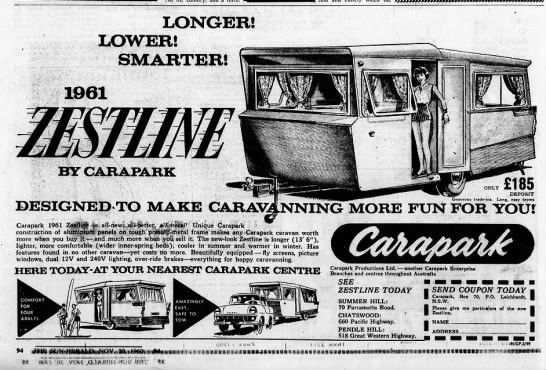 The final advert is the most intriguing! It was published in the Melbourne Age on Saturday, 2 December 1961 (page 59) by Carapark Productions Pty Ltd and offers brand new Southern Cross caravans for sale: 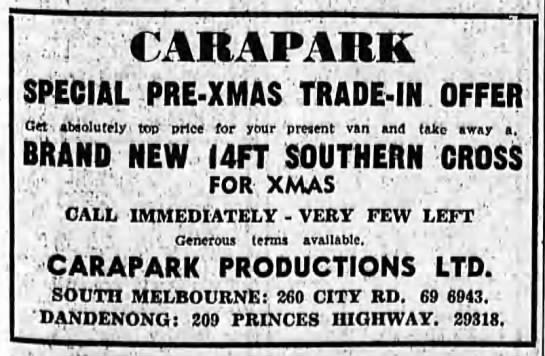 We have seen a couple of references to Southern Cross caravans on the forum over the years but have found very little information on them beyond two adverts from 1960, one of which is also a Carapark advert for its own vans as well several other brands. Perhaps Carapark may have been acting as an agent for Southern Cross in Melbourne, but this advert raises another interesting possibility... Was 'Southern Cross' the name Carapark used for its vans in Victoria? While that may sound a bit unlikely, we know that Carapark used the brand name 'Leisureliner' for its caravans built in Queensland. And it seems to have adopted the 'Paramount' name for toaster style caravans built in South Australia. Hopefully we will discover some further info about Southern Cross vans as time goes by. However, for the moment I will also post this advert on the Southern Cross thread. Don Ricardo |
|
|
|
Post by Don Ricardo on Jul 30, 2020 15:51:34 GMT 10
|
|
|
|
Post by alfredandbob on Aug 10, 2020 21:30:59 GMT 10
Hi all. So glad to join this forum and find out more about our toaster. Does anyone know how to work out the year from the serial number which 160? Ours is polished with two portholes, one each side. Whilst there is no interior left I can see from the floor tiles that it would have had bench seating. The back windows are two long stacked on top of each other rather than side by side.
Also there is no vin type number on the chassis. I’m assuming given the era it would be just the badge at the back of the van acting as the vin number? We found this in some A30 sedans, rather than attaching it to the body they put it on the visor.
|
|
|
|
Post by Don Ricardo on Aug 10, 2020 23:14:05 GMT 10
Hi Alfredandbob, Welcome to the forum and for telling us about your Carapark toaster. Unfortunately as far as we can tell Carapark had a bit of a random approach to serial numbers, so the number 160 tells us the build number in the year it was built, but doesn’t tell us the year as such. Some Caraparks have a serial number engraved on an arm of the drawbar which includes the year. It takes a bit to find it if it’s there, and it may be hidden under a few layers of paint. There are a couple of people on the forum who know a fair bit about Carapark toasters and who, in the absence of an engraved serial number on the drawbar, can give you an indication of the date of your van based on the windows, etc. So as a first step, I suggest that you post some photos of your van here and we’ll see what we can work out from them. There are instructions on how to post photos in the ‘Forum Guidelines & Helpful Hints’ section of the forum - click here. If you have any trouble with the photos, let us know and we will help you, so don’t give up. And we will certainly help you figure out as much as we can about your van. Everyone on the forum enjoys hearing about a new van.    Don Ricardo |
|
|
|
Post by Don Ricardo on Aug 13, 2020 12:32:08 GMT 10
1962 Carapark Zestline 15/9 in original condition with what appears to be an intact interior listed on Gumtree in January 2018  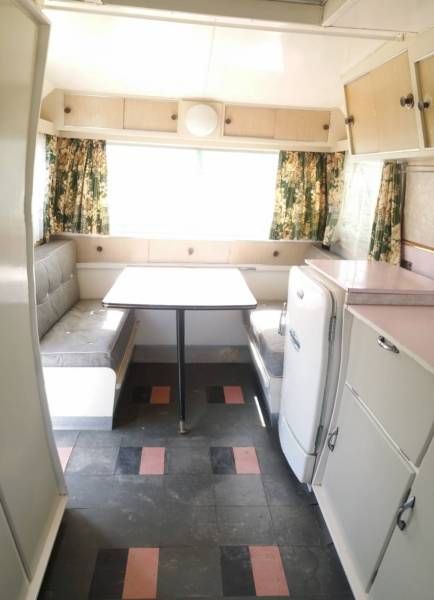 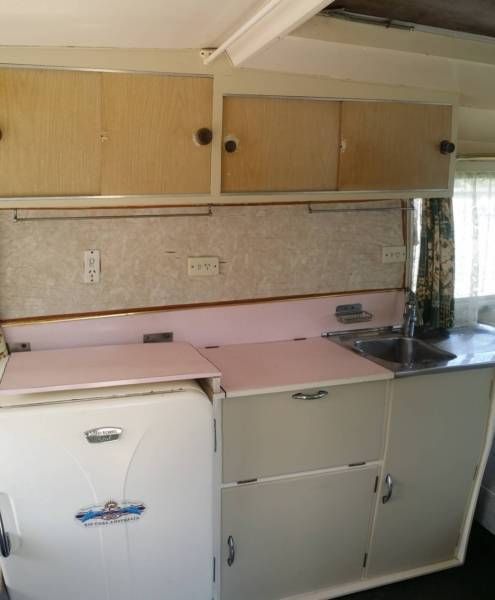 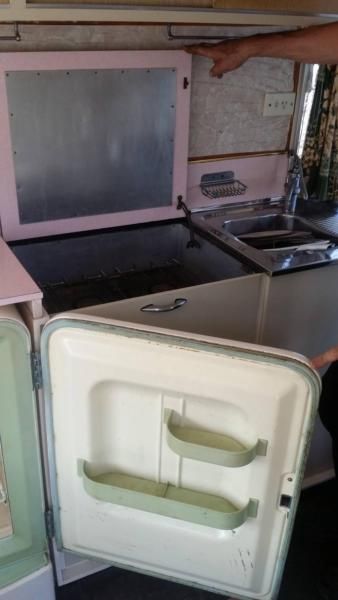 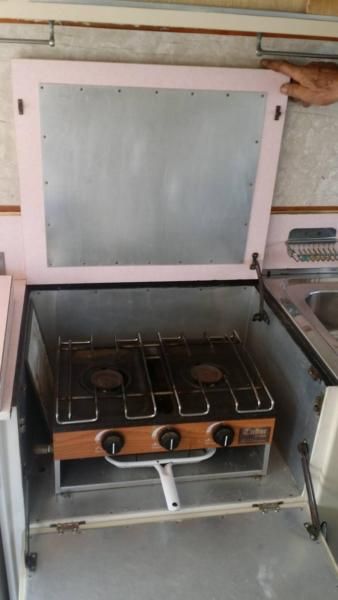 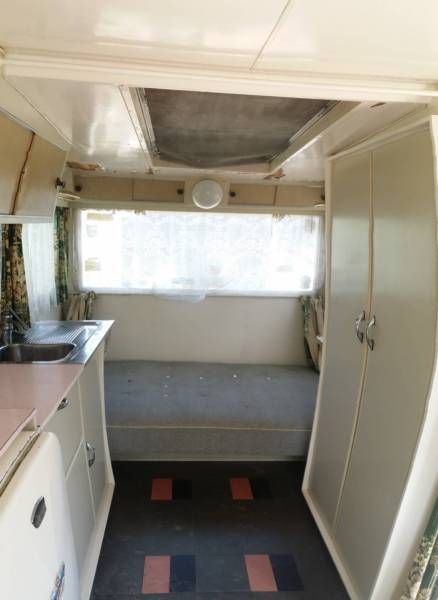 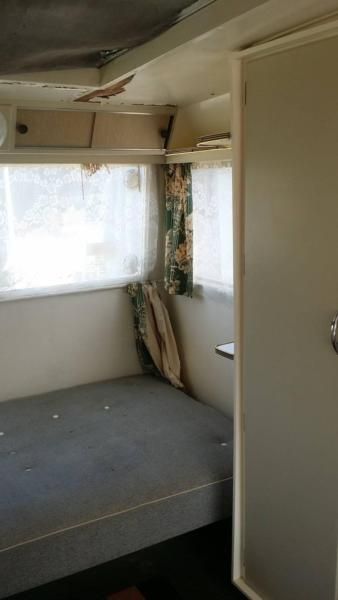
|
|
|
|
Post by Don Ricardo on Aug 15, 2020 12:24:01 GMT 10
Morning vintage vanners, Below is an article published on Sunday, 3 September 1939 in the Sydney Sun (page 28) on the day that war was declared at the beginning of World War II. The article was accompanied by several photos of caravans, one English and the another American. But the middle photo is of an Australian Caravan Park van that is shown higher up this thread: _Sun_3Sept1939_p28_article231213658.jpg?width=1920&height=1080&fit=bounds) _Sun_3Sept1939_p28_article231213595.jpg?width=1920&height=1080&fit=bounds)
The article discusses the potential use of caravans for accommodation during a time of war. The Sun would not have known that war would be declared on the very day the article was published, but the possibility of war had been brewing for some time as the article indicates.
The last two paragraphs are of particular interest. As it happens RJ Rankin and Caravan Park became very involved in providing caravans for defence and domestic accommodation during the war, and arguably that provided them with a lifeline which enabled them to rebuild after the war when so many other pre-war manufacturers had disappeared.
Don Ricardo
|
|
|
|
Post by Don Ricardo on Aug 16, 2020 22:44:25 GMT 10
G'day all, I recently found this advert for Caravan Park caravans printed in the Sydney Sun on Sunday, 25 September 1938 (page 25): _Sun_25Sept1938_p25_article230812880_D.jpg?width=1920&height=1080&fit=bounds) (Source: National Library of Australia nla.gov.au/nla.news-article230812880 ) We've seen a later advert for this same model caravan on the forum before, but this advert includes some additional facts about the van. What hit me like a thunderbolt is that the advert tells us that the van is clad in 'all steel body panels'. That reminded me that the little Caravan Park 10 ft model shown in the post immediately before this was also metal clad. These vans were amongst the first models produced by Caravan Park. This means that Caravan Park was producing steel clad caravans from the very beginning when it started to build caravans in 1938. We've tended to think that the steel clad Caravan Park Superb produced after the war was the first steel clad model, but it turns out this was not the case. In that sense, Caravan Park's products before the war were different from most other commercially produced caravans, which were clad in bondwood. The advert was accompanied on the same page of the Sydney Sun by the following article extolling the virtues of caravanning. The person writing the article had hired a caravan - from guess who - and the article includes a photo of a Caravan Park caravan in 'a picturesque setting by the sea near Lake Tabourie'. An example of a Caravan Park advertorial then, no doubt arranged by RJ Rankin who was nothing if not an experienced and canny salesman. _Sun_25Sept1938_p25_article230812879_A.jpg?width=1920&height=1080&fit=bounds) _Sun_25Sept1938_p25_article230812879_B.jpg?width=1920&height=1080&fit=bounds) _Sun_25Sept1938_p25_article230812879_C.jpg?width=1920&height=1080&fit=bounds) (Source: National Library of Australia nla.gov.au/nla.news-article230812879 ) Don Ricardo |
|
|
|
Post by Don Ricardo on Aug 17, 2020 14:37:26 GMT 10
Hi all, In a previous post on this thread a couple of days ago, I commented on the fact that RJ Rankin, the founder of Caravan Park, provided caravans for accommodation of service personnel and domestic use during World War II. In fact the war provided Rankin with substantial opportunities to expand his business. His hire caravans were often located near war industries or defence facilities where workers were having trouble finding accommodation. Below are a couple of newspaper articles from 1943 which provide examples of his activities. The first was published in the Sydney Sun on Friday, 22 January 1943 (page 3) and tells us about a family living in a caravan at Matraville which was hired from Rankin's company Caravan Lettings Prop Ltd. Rankin established that company during the war specifically for this purpose. _Fri_22Jan1943_p3_article231743608.jpg?width=1920&height=1080&fit=bounds) The second article printed in the Sydney Sun on Sunday, 5 December 1943 (page 6) tells us about a family living in a hired caravan while they built their own house at Miranda on weekends. Again the caravan was hired from Rankin.
Given the quotes from Rankin in both articles it seems quite likely that they were initiated by him. Another case of his advertorials perhaps?
Neither of the caravans featured in the articles appear to be Caravan Park vehicles, and our understanding is that Rankin bought up a lot of different caravans from private owners (or perhaps other manufacturers?) to be used by his Caravan Lettings company.
Don Ricardo
|
|
|
|
Post by Don Ricardo on Nov 22, 2020 22:32:33 GMT 10
|
|